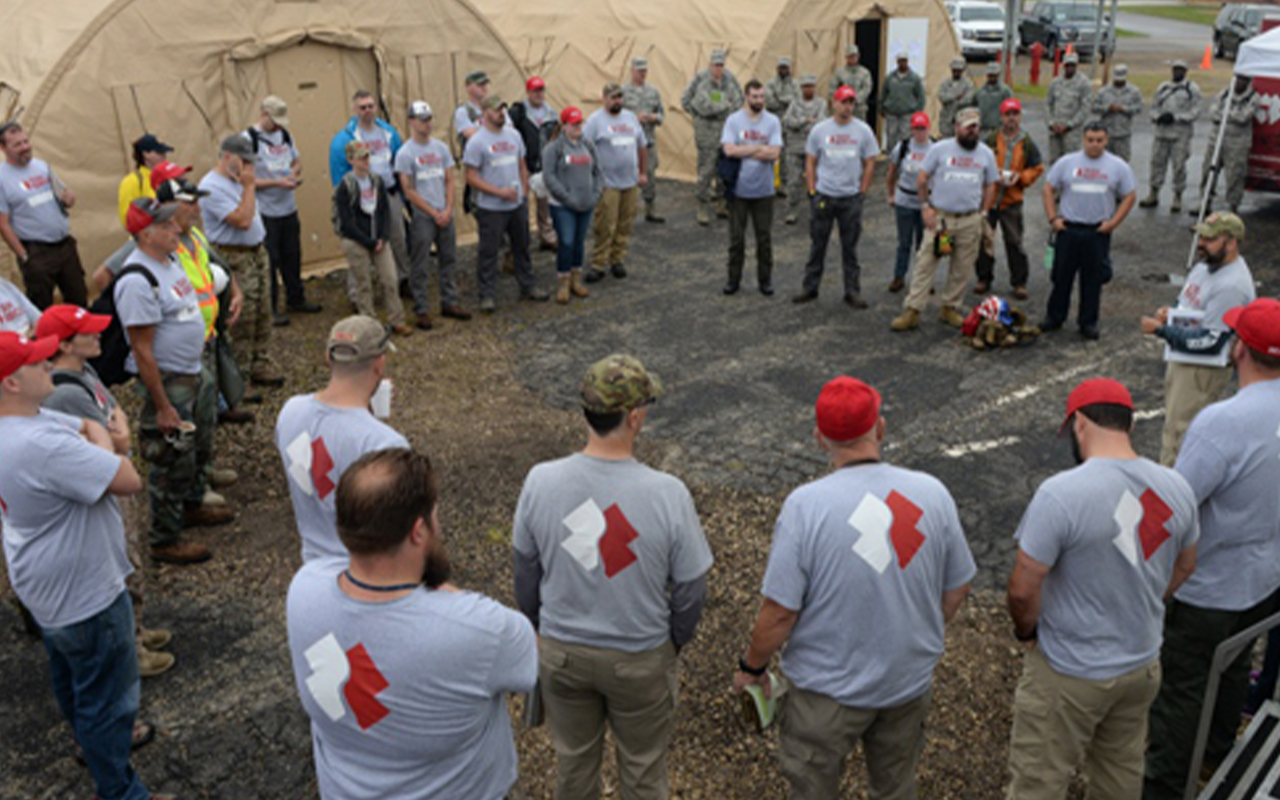The focus of PATRIOT’s tactical level domestic response has matured to increase understanding of interagency and multidisciplinary coordination, policies, and doctrine, and to develop procedures and processes that could be adopted elsewhere. The best practices and lessons learned are relevant to any local and state emergency managers, and strengthen knowledge about how the military can provide support to civilian authorities.
The PATRIOT Exercise Program has evolved beyond being just a premier biannual domestic operations (DOMOPS) training exercise sponsored by the National Guard Bureau and accredited by the Joint National Training Capability Program. It is an excellent forum for military partners to coordinate with local, state, tribal, and federal civilian organizations, as well as nongovernment and private sector organizations in Federal Emergency Management Agency (FEMA) Regions IV and V. FEMA Region IV encompasses the states of Alabama, Florida, Georgia, Kentucky, Mississippi, North Carolina, South Carolina, and Tennessee; whereas FEMA Region V consists of Illinois, Indiana, Michigan, Minnesota, Ohio, and Wisconsin.
Evolution of a Turnkey, Full-Scale Exercise
The biannual PATRIOT Exercise held at Volk Field, Wisconsin, and Gulfport/Camp Shelby, Mississippi, provides a vast array of training venues and support services that allow participants to step into a “turnkey” full-scale exercise. The venues include remote areas suitable for wide-area searches, ground-to-air operations, search and rescue, collapsed structure response, debris removal operations, and more; supplemented with a wide range of role-play support, modeling, and simulation, and subject matter experts to provide further realism.
PATRIOT planners provide a backdrop that realistically aligns military capabilities against projected civilian shortfalls. The host military facilities provide low-cost feeding and lodging for civilian organizations to support the exercise development through the three major planning meetings. This support continues into exercise conduct for participants, culminating in a rewarding exercise experience that has included more than 1,000 people annually.
The successfully collaborative practices of the PATRIOT Exercise Program, which is supported by and compliant with the National Incident Management System (NIMS) and Homeland Security Exercise and Evaluation Program, leverage existing processes that institutionalize NIMS concepts and principles such as the Incident Command System, interoperable communications, and resource management. For example, the program provides a venue for Type 3 All-Hazards Incident Management Teams (AHIMT) to train and complete position task books while managing a complex response to a realistic disaster scenario. Type 3 AHIMTs are local, regional, state, or tribal level multiagency/multijurisdictional teams used to manage incidents spanning multiple operational periods. These teams are typically deployed with 10-20 trained personnel, and are capable of managing major and/or complex incidents requiring a significant number of local, state, or tribal resources. The complexity of incidents require a written incident action plan, that can later transition and transfer to a national level AHIMT.
Lessons learned from Hurricane Katrina in 2005 and other events provided the impetus for embedding military liaison officers into the branch, division, and incident management team levels. This practice improves coordination for patient treatment and information tracking between the United States Transportation Command (TRANSCOM) Regulating and Command and Control Evacuation System (TRAC2ES) and civilian systems, de-conflicts real-world and exercise logistics, and establishes a process for data collection and dissemination. The development of position descriptions and job aids for liaison officers are proving invaluable for the military/civilian interface at both the incident command and operations center levels.
In 2015, PATRIOT was the first exercise to integrate military rotary, fixed-wing, and remote-piloted aircraft in support of domestic operations by successfully executing the request for proper use memorandum, signed off by the secretary of defense to comply with real-world intelligence oversight expectations. The military fills resource shortfalls in supplementing civilian air operations, including the Civil Air Patrol, hospital medical flights, and more.
Building Mutual Military-Civilian Understanding
Military partners are required to meld into civilian processes to learn key lessons in resource management, operational planning, and accountability. Emergency managers should be aware that PATRIOT uses the Civil Support Task List for military units to explain which DOMOPS capabilities they will implement. The Civil Support Task List is a resource-typing list, a directory of capabilities that could be used as a crosswalk back to the core capabilities to which civilian organizations are accustomed to referring. This is a realm worthy of continued familiarization and further development.
PATRIOT Exercise scenarios test select core capabilities such as situational assessment, operational communications, mass care, and mass search and rescue operations. In addition, the military provides assets and resources to fill local shortfalls. An important lesson learned was that “planning” and “operations” in the conventional incident command sense meant different things to civilians and military personnel. The civilian world typically sees persons providing situational awareness, data display, and collection management within the planning section as a function. The military looks at this through an operational lens rather than the planning paradigm.
For example, the planning staff functioning within the Incident Command System is responsible for collecting, evaluating, and disseminating the tactical information related to the incident, and for preparing and documenting incident action plans. The planning section develops “action plans” that are implemented through operations, where the tactical resources exist. The traditional military paradigm views the development of plans from the wartime top-down joint operational planning perspective, where deliberate planning such as operational (OPLAN), communications (CONPLAN), functional and crisis-action planning like the Campaign Plan, and Operational Order (OPORD) are developed. The military’s Joint Staff system provides structuring that state-level planners recognize such as the J3 rating for operations and J5 for planning.
The “J” refers to Joint Staff in military lexicon, and is the staff of specified command, joint task force, or subordinate functional component that employs forces from more than one military department, and will include members from the several services comprising the force. These members should be assigned in such a manner as to ensure that the commander understands the tactics, techniques, capabilities, needs, and limitations of the component parts of the force. Positions on the staff should be divided so that service representation and influence generally reflect the service composition of the force. The J5 develops higher-level strategic plans, which are then handed off to the J3 to write future plans, or plans to be executed.
For this reason, military liaison officers in air operations coordinated information awareness and assessment in concert with the operations section, rather than planning section within the Incident Command System construct. The visual and data products were shared with the requesting consumer once developed – for example, maps for wide-area searches shared between search and rescue (SAR) task force, combat controllers establishing communications in remote areas, and command to coordinate SAR operations.
The planning “P” process is used to develop the incident action plan that drives the exercise. The discussion-based exercise enables participants to discuss legal, statutory, regulatory, and procedural challenges such as use of force and airspace, as well as information collection and sharing. PATRIOT North 16 in Wisconsin led to best practices in developing operating procedures for task force/strike team operations integrating military security forces, civilian law enforcement, military Religious Support Teams, and Salvation Army Spiritual Care Teams during a holistic response to aid an isolated community. Active shooter and civil disturbance vignettes created realistic levels for close coordination between these entities.
Military emergency managers found it helpful to learn tradecraft from their civilian counterparts when staffing various planning and logistic section units within the Incident Management Team. Emerging technology was explored, such as the no-cost DOMOPS Awareness and Assessment Response Tool (DAART), which is available to civilian organizations. The DAART provides: a flexible, scalable, and safe portal to share documents; processes such as flight scheduling to support incident assessment missions; resource ordering; and static and video data imaging to improve situational assessment and aid in establishing a common operating picture. The DAART can also be used for everyday events and incidents such as the 2016 and 2017 Super Bowls.
A Growing Number of Partnerships
Examples of growing PATRIOT partnerships include Team Rubicon, Salvation Army, American Red Cross, Civil Air Patrol, local law enforcement, fire departments and rescue companies, local hospitals and medical centers, Occupational Safety and Health Administration, and others. Although the exercise venues are limited to the two certified training areas of Hattiesburg, Mississippi, and Volk Field, Wisconsin, this does not preclude civilian organizations or entities from coming from outside the two FEMA regions. Self-nominations are reviewed and vetted by the planning team during the appropriate time, and the past participants are testimony to the enduring benefits derived at the PATRIOT Exercise.
These mutually beneficial partnerships are growing, with almost every state being represented by National Guard units at one time or another. Although all exercises and trainings have their inherent value, the PATRIOT Exercise Program offers a unique opportunity to advance and enhance national capabilities across National Guard units and among a vast civilian audience. At the PATRIOT Exercise, military and civilian participants are moving past mere NIMS compliance to becoming competent in the perishable skills needed to sustain an effective disaster response. More information, pictures, and videos of past PATRIOT exercises can be found on the National Guard PATRIOT Exercise Facebook page.

Jeffrey Driskill Sr.
Dr. Jeffrey Driskill Sr. is currently a government contractor working as an exercise planner with the National Guard Bureau in Arlington, Virginia. Before his current position, he served as deputy emergency management coordinator with the City of Alexandria, Virginia, and is a retired chief of police, Certified Emergency Manager (CEM), and Master Exercise Practitioner Program (MEP) graduate. He holds a Doctor of Business Administration in Homeland Security Policy and Leadership from Northcentral University and is a subject matter expert in the NIMS doctrine.
-
Jeffrey Driskill Sr.https://www.domesticpreparedness.com/author/jeffrey-driskill-sr






